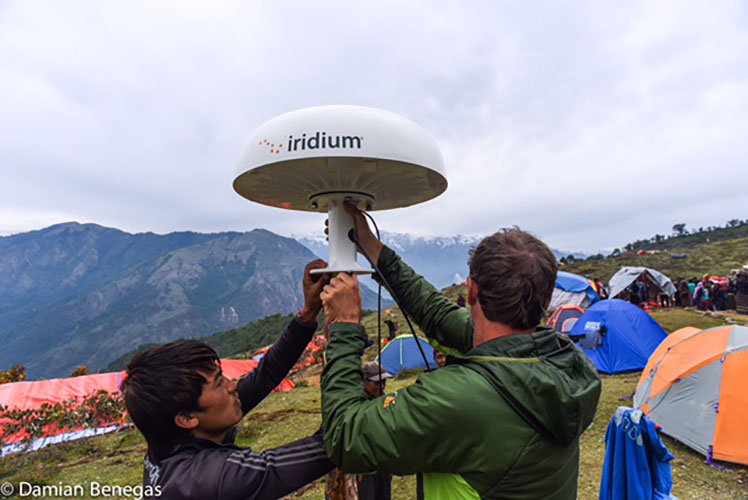One of the main responsibilities of the government is protecting its citizens. And some of the largest threats to our safety and security within our borders are natural disasters and other emergency situations.
As witnessed by Hurricane Sandy, Katrina and other natural disasters, responding to a disaster situation and working to rescue American citizens can be just as dangerous as being on the ground during a disaster, itself. To keep first responders connected and safe – whether they are local emergency personnel, FEMA or even the National Guard – they require communications back to headquarters or senior leaders that are coordinating rescue efforts.
Unfortunately, communication services aren’t always easy to come by in the aftermath of a disaster.
In the wake of 9/11, a massive wave of cellphone calls, text messages and other communications both into and out of New York City overwhelmed cellular networks and made it nearly impossible for people to use their cell phones. In the wake of Hurricane Katrina, cellular and other communications infrastructures were so badly damaged or destroyed that they simply weren’t available for residents or first responders.
When responding to emergencies and disasters, it’s essential that personnel stay coordinated. Sending new orders to personnel in the field in a timely and effective manner can literally mean the difference between a civilian life that is saved and one that is lost. Keeping lines of communication open between first responders and their senior leaders is necessary should they be in distress. None of this is possible when communications infrastructure is overloaded or destroyed.
This is why satellites play such an important role in disaster response and recovery.
Utilizing today’s advanced COMSATCOM services, disaster response and recovery personnel can be connected almost immediately. Thanks to advancements in satellite technologies – more advanced, higher-bandwidth connectivity can be rolled out as the response activities are underway to provider advanced capabilities to responders.
When disaster first strikes and emergency responders are on the scene, they can utilize satellite phones and other devices that function on the Broadband Global Area Network (BGAN). This allows for almost immediate voice calls and connectivity when cellular networks and other communications infrastructures are down.
Unfortunately, BGAN terminals and other equipment offer low bandwidth and high latency. They’re good for getting voice connectivity to first responders for basic voice and data connectivity, but they struggle to effectively provide more advanced functionality – such as video collaboration with senior leaders or the ability to download high-quality, high resolution maps and images without exorbitant cost. Ultimately, they’re fast, mobile, easily-deployable solutions that can enable voice connectivity into the field immediately when no other option is available.
Satellite acceleration products like the ones provided by XipLink build a VAT (Virtual Accelerated Tunnel) that emulates the properties of terrestrial networks so Internet (or private terrestrial network) resources think that they are dealing with another terrestrial node – rather than one connected via satellite. The end result is that data of any kind (including Voice Over IP) is sent more efficiently, increasing the throughput of the satellite link and reducing the amount of data needed to accomplish communications.
When a much more efficient and expedited response to a disaster is paramount, technologies with the ability to deliver higher throughputs and more advanced capabilities can be brought to the disaster response and recovery site to enable communications.
First, there’s the Cell on Wheels (COW), which provides robust, deployable communications infrastructure with a set-up time from a stowed configuration to operations within minutes and will support multiple and simultaneous voice, video, VTC, and other IP-based data streams. These devices are capable of delivering access to GEO satellite constellations that can deliver higher-bandwidth and higher quality communications to the first responder and senior leaders in the field.

However, these solutions still can’t offer fiber-like connectivity, and that’s where Medium Earth Orbit (MEO) satellites play a role in disaster response.
In disaster situations, a beam from a MEO satellite – such as those utilized by satellite provider, O3b – could be directed to the disaster site. Smaller spot beams and the proximity of the MEO satellite to the Earth enables it to deliver throughput and latency that are significantly superior to any GEO satellite, enabling first responders, senior leaders, emergency operations centers and other facilities to have connectivity on-par with a fiber connection.
This means that emergency operations centers can stay connected and coordinated via VTC, senior leaders can receive HD video, high quality images and other visual intelligence from the impacted area to help them make informed decisions and the actual first-responder in the field can stay in touch and receive all necessary information that they need to keep themselves safe and find their way to those in need of assistance in the most effective and efficient manner. Local communications operators can even use the MEO connection to re-establish broadband internet and 3G or 4G services to the impacted population at large.

MEO satellites have proven capabilities, and should be included in any coordinated disaster response and emergency preparedness plans. The technology is groundbreaking, and transportable satellite dishes and infrastructure necessary to connect with these MEO constellations—such as the AvL 85 cm flyaway antenna which can be set up and online in under 90 minutes—are available today. As more emergency response organizations see the impressive connections speeds and almost imperceptible latency of MEO satellite constellations – such as those offered by O3b – they’ll quickly take steps to acquire the necessary terrestrial hardware to make these satellites a part of their disaster response and recovery plans moving forward.
For additional information on the role that satellites can play in disaster response, download the White Paper on the SES emergency.lu platform by clicking HERE. For more information on MEO satellites, download the O3b White Paper, “Fiber-Like Satellite Communications for U.S. Government Applications,” by clicking HERE.
